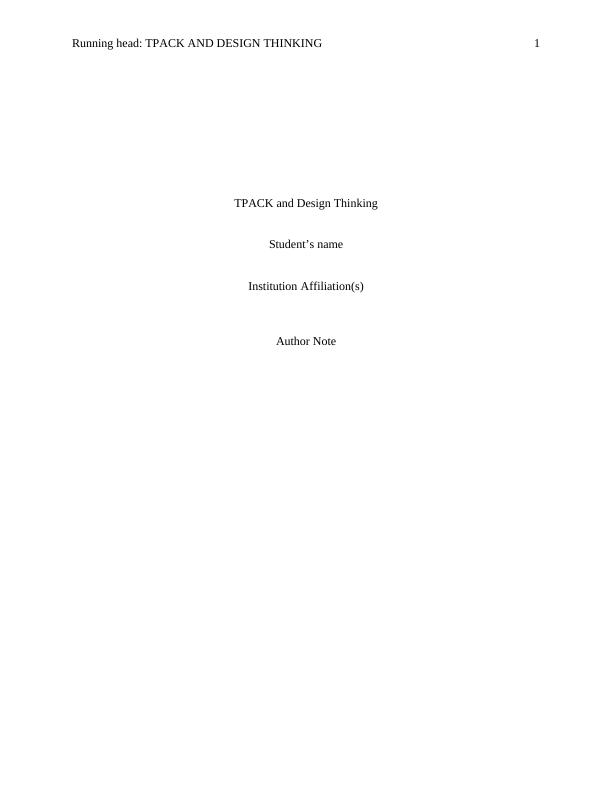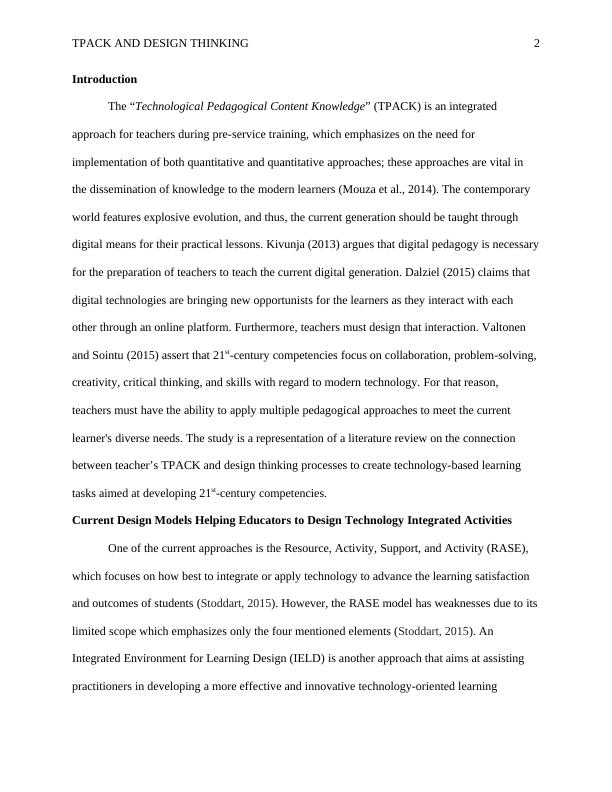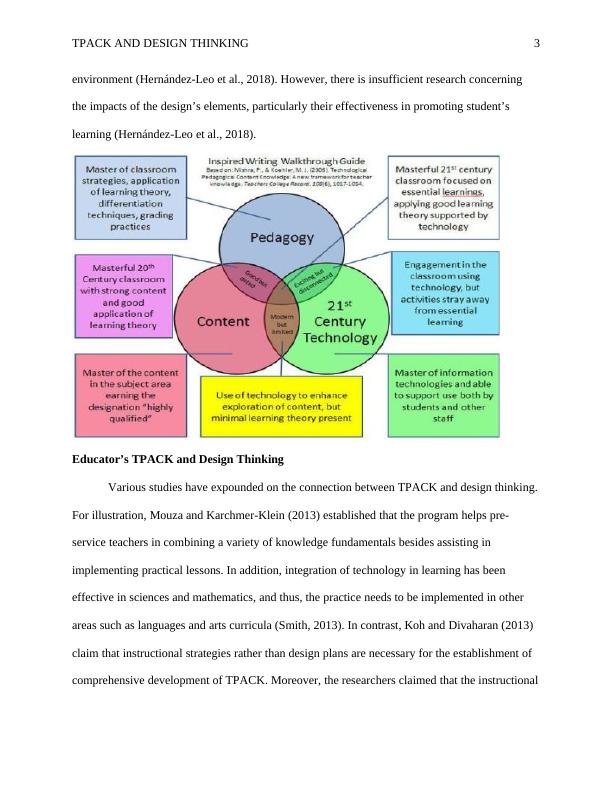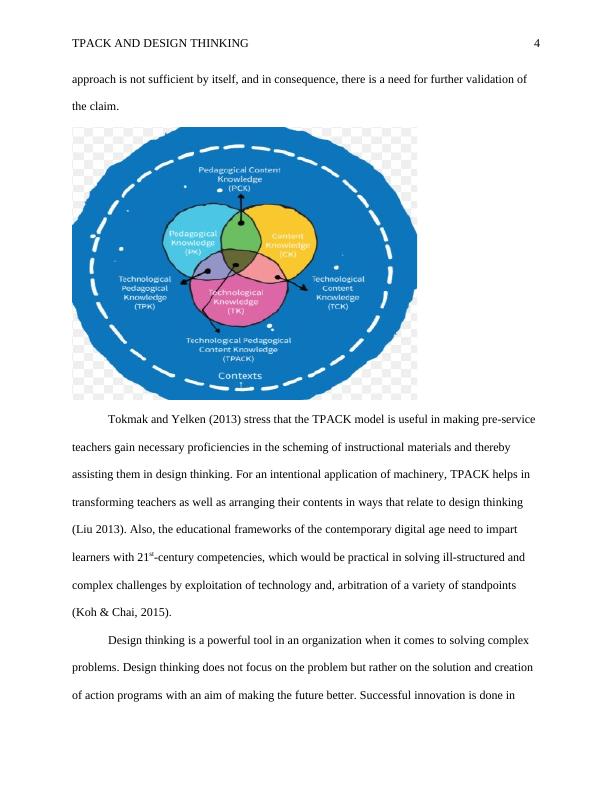TPACK and Design Thinking -An Overview
Added on 2022-08-17
13 Pages3895 Words22 Views
Running head: TPACK AND DESIGN THINKING 1
TPACK and Design Thinking
Student’s name
Institution Affiliation(s)
Author Note
TPACK and Design Thinking
Student’s name
Institution Affiliation(s)
Author Note

TPACK AND DESIGN THINKING 2
Introduction
The “Technological Pedagogical Content Knowledge” (TPACK) is an integrated
approach for teachers during pre-service training, which emphasizes on the need for
implementation of both quantitative and quantitative approaches; these approaches are vital in
the dissemination of knowledge to the modern learners (Mouza et al., 2014). The contemporary
world features explosive evolution, and thus, the current generation should be taught through
digital means for their practical lessons. Kivunja (2013) argues that digital pedagogy is necessary
for the preparation of teachers to teach the current digital generation. Dalziel (2015) claims that
digital technologies are bringing new opportunists for the learners as they interact with each
other through an online platform. Furthermore, teachers must design that interaction. Valtonen
and Sointu (2015) assert that 21st-century competencies focus on collaboration, problem-solving,
creativity, critical thinking, and skills with regard to modern technology. For that reason,
teachers must have the ability to apply multiple pedagogical approaches to meet the current
learner's diverse needs. The study is a representation of a literature review on the connection
between teacher’s TPACK and design thinking processes to create technology-based learning
tasks aimed at developing 21st-century competencies.
Current Design Models Helping Educators to Design Technology Integrated Activities
One of the current approaches is the Resource, Activity, Support, and Activity (RASE),
which focuses on how best to integrate or apply technology to advance the learning satisfaction
and outcomes of students (Stoddart, 2015). However, the RASE model has weaknesses due to its
limited scope which emphasizes only the four mentioned elements (Stoddart, 2015). An
Integrated Environment for Learning Design (IELD) is another approach that aims at assisting
practitioners in developing a more effective and innovative technology-oriented learning
Introduction
The “Technological Pedagogical Content Knowledge” (TPACK) is an integrated
approach for teachers during pre-service training, which emphasizes on the need for
implementation of both quantitative and quantitative approaches; these approaches are vital in
the dissemination of knowledge to the modern learners (Mouza et al., 2014). The contemporary
world features explosive evolution, and thus, the current generation should be taught through
digital means for their practical lessons. Kivunja (2013) argues that digital pedagogy is necessary
for the preparation of teachers to teach the current digital generation. Dalziel (2015) claims that
digital technologies are bringing new opportunists for the learners as they interact with each
other through an online platform. Furthermore, teachers must design that interaction. Valtonen
and Sointu (2015) assert that 21st-century competencies focus on collaboration, problem-solving,
creativity, critical thinking, and skills with regard to modern technology. For that reason,
teachers must have the ability to apply multiple pedagogical approaches to meet the current
learner's diverse needs. The study is a representation of a literature review on the connection
between teacher’s TPACK and design thinking processes to create technology-based learning
tasks aimed at developing 21st-century competencies.
Current Design Models Helping Educators to Design Technology Integrated Activities
One of the current approaches is the Resource, Activity, Support, and Activity (RASE),
which focuses on how best to integrate or apply technology to advance the learning satisfaction
and outcomes of students (Stoddart, 2015). However, the RASE model has weaknesses due to its
limited scope which emphasizes only the four mentioned elements (Stoddart, 2015). An
Integrated Environment for Learning Design (IELD) is another approach that aims at assisting
practitioners in developing a more effective and innovative technology-oriented learning

TPACK AND DESIGN THINKING 3
environment (Hernández-Leo et al., 2018). However, there is insufficient research concerning
the impacts of the design’s elements, particularly their effectiveness in promoting student’s
learning (Hernández-Leo et al., 2018).
Educator’s TPACK and Design Thinking
Various studies have expounded on the connection between TPACK and design thinking.
For illustration, Mouza and Karchmer-Klein (2013) established that the program helps pre-
service teachers in combining a variety of knowledge fundamentals besides assisting in
implementing practical lessons. In addition, integration of technology in learning has been
effective in sciences and mathematics, and thus, the practice needs to be implemented in other
areas such as languages and arts curricula (Smith, 2013). In contrast, Koh and Divaharan (2013)
claim that instructional strategies rather than design plans are necessary for the establishment of
comprehensive development of TPACK. Moreover, the researchers claimed that the instructional
environment (Hernández-Leo et al., 2018). However, there is insufficient research concerning
the impacts of the design’s elements, particularly their effectiveness in promoting student’s
learning (Hernández-Leo et al., 2018).
Educator’s TPACK and Design Thinking
Various studies have expounded on the connection between TPACK and design thinking.
For illustration, Mouza and Karchmer-Klein (2013) established that the program helps pre-
service teachers in combining a variety of knowledge fundamentals besides assisting in
implementing practical lessons. In addition, integration of technology in learning has been
effective in sciences and mathematics, and thus, the practice needs to be implemented in other
areas such as languages and arts curricula (Smith, 2013). In contrast, Koh and Divaharan (2013)
claim that instructional strategies rather than design plans are necessary for the establishment of
comprehensive development of TPACK. Moreover, the researchers claimed that the instructional

TPACK AND DESIGN THINKING 4
approach is not sufficient by itself, and in consequence, there is a need for further validation of
the claim.
Tokmak and Yelken (2013) stress that the TPACK model is useful in making pre-service
teachers gain necessary proficiencies in the scheming of instructional materials and thereby
assisting them in design thinking. For an intentional application of machinery, TPACK helps in
transforming teachers as well as arranging their contents in ways that relate to design thinking
(Liu 2013). Also, the educational frameworks of the contemporary digital age need to impart
learners with 21st-century competencies, which would be practical in solving ill-structured and
complex challenges by exploitation of technology and, arbitration of a variety of standpoints
(Koh & Chai, 2015).
Design thinking is a powerful tool in an organization when it comes to solving complex
problems. Design thinking does not focus on the problem but rather on the solution and creation
of action programs with an aim of making the future better. Successful innovation is done in
approach is not sufficient by itself, and in consequence, there is a need for further validation of
the claim.
Tokmak and Yelken (2013) stress that the TPACK model is useful in making pre-service
teachers gain necessary proficiencies in the scheming of instructional materials and thereby
assisting them in design thinking. For an intentional application of machinery, TPACK helps in
transforming teachers as well as arranging their contents in ways that relate to design thinking
(Liu 2013). Also, the educational frameworks of the contemporary digital age need to impart
learners with 21st-century competencies, which would be practical in solving ill-structured and
complex challenges by exploitation of technology and, arbitration of a variety of standpoints
(Koh & Chai, 2015).
Design thinking is a powerful tool in an organization when it comes to solving complex
problems. Design thinking does not focus on the problem but rather on the solution and creation
of action programs with an aim of making the future better. Successful innovation is done in

End of preview
Want to access all the pages? Upload your documents or become a member.
